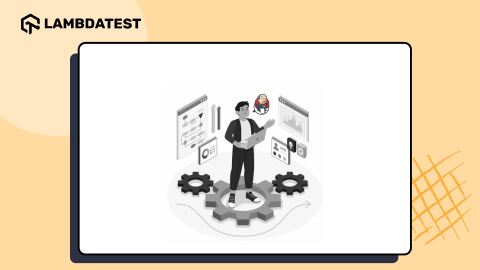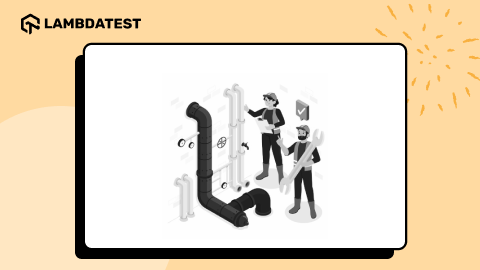Jenkins vs Travis vs Bamboo vs TeamCity: Clash Of The Titans
Rahul Jain
Posted On: October 22, 2020
![]() 61049 Views
61049 Views
![]() 22 Min Read
22 Min Read
What’s the first thing that comes to mind when you hear the words Software Development and DevOps? There’s only one magic word (five to be more precise)- Continuous Integration and Continuous Delivery.
It is impossible to carry out software development without counting on DevOps testing or CI/CD tools, making picking the right CI/CD tool super important. Now the question is, how do you choose the right tool as there is no shortage of options? Well, to make it a little easier for you, we have picked four of the best CI/CD tools, and we will be comparing these tools: Jenkins vs. Travis vs. Bamboo vs. TeamCity in the article so that you can make an informed decision.
Why Are CI/CD Tools Important?
When multiple team members work on the same project, it can often get agonizing for developers to contribute to the end code. They need to communicate and coordinate all sorts of modifications manually. This synchronization goes far beyond the development team, as it’s not just the developers who are responsible for all product features.
For example, software product teams tend to strategize a sequence of feature introductions and choose individuals to be in charge of each feature. But the larger the team gets, so do the chances of code failures. Without any fail-safe in place, this often leads to a vicious cycle of blame.
To mitigate this blame game and bring some relief to developers, CI (Continuous Integration) was introduced. In essence, continuous integration is the practice of regularly merging all working copies of code to a shared channel or repository numerous times a day. CI brings together all the code alterations in a single place, prepares their production, then prepares and tests the code release.
Each of these steps aids in improving the quality of the code, reducing all sorts of human error in code review, and ultimately saving precious time and effort. And thus arises the need to choose the best Continuous Integration/Continuous Delivery tools among a plethora of options available to us. As promised above, this blog will talk about the much-heated battle between Jenkins vs Travis vs Bamboo vs TeamCity.
Digging Deeper Into CI/CD
Before jumping into CI/CD tools and comparing Jenkins vs Travis vs Bamboo vs TeamCity, we first need to understand CI/CD better. CI/CD mainly denotes the software development & testing infrastructure that intends to bring out quality products with less effort and time. In a nutshell, Continuous Integration (CI)/Continuous Delivery (CD) typically goes hand in hand with an agile environment. This entire process allows software development teams to incorporate, authenticate, fix errors, and set up code to the production environment automatically.
Key Objectives Of CI/CD
- Offer instant feedback about the quality of the code to software developers.
- Automate tests and build a document trail.
- Allow developers to spend relatively more time writing codes than in testing or integrating fresh code with the present codebase.
Major Distinctions: Continuous Integration, Continuous Deployment, & Continuous Delivery
Continuous Integration (CI) is the initial phase for Continuous Delivery & Continuous Deployment. CI is a discipline that mainly helps developers combine pieces of their code into one major code branch without any break in the collective code. CI runs test automation so that bugs would not slip into the code and guarantees that the end-product does not break every time fresh commits are incorporated into the mainline.
Both Continuous Deployment and Continuous Delivery are what comes about when the modifications have moved through each phase of development and are ready to be released. A CI/CD pipeline is the best practice to systematize the complete development process. Generally, it is broken into phases so software developers can get rapid response or feedback.
Continuous Delivery (CD) is the method for releasing the alteration. Continuous Integration guarantees that all changes in the code are combined regularly in an automated mode. On the flip side, the CD is the practice that permits developers to release fresh alterations from the source code repository to end-users. With CD (Continuous Delivery), this procedure gets automated and organized– you simply need to click a button at any time you are ready to deploy.
You can essentially decide the rhythm that better meets your business requirements and release monthly, weekly, daily, etc. The goto way would be to release it early. If there were an issue with the code, small batches would be simpler to fix compared to large modifications.
However, Continuous Deployment is a wholly automated and highly advanced version of Continuous Delivery. After going through the phases mentioned above of the production pipeline, alterations can be released to your users via automatic releases. This again eliminates the probability of human errors.
Automated releases let the software development team concentrate on their job and stop stressing about ‘Release Day.’ Moreover, they can get customer response or feedback quite rapidly and check the consequences or results of their work within minutes of completing it. To put it plainly, CI lays the base for Continuous Deployment and Continuous Delivery. These two are more alike – both of them can help release changes; however, as a contrast, Continuous Deployment releases occur automatically.
All releases, irrespective of which one of the CDs you choose, follow a specific release workflow. Typically, the release workflow is categorised into stages:
- Define Plan – recording of primary information, define release package, schedule, and release plans, conveying tasks to members of the team.
- Release Build – generating one or more release packages.
- Testing Phase– tests the release build in mock environments.
- Notes or Document – generating release documents.
- Approve deployment to a live environment – the approval of deployment of the release to a live situation and surroundings.
- Deployment Phase – to deploy the release to a live situation.
- Review the Final Release– to record final details, finishing the release.
Commercial Benefits Of CI/CD
It is essential to understand the commercial aspects of CI/CD tools before comparing Jenkins vs Travis vs Bamboo vs TeamCity. This section will help you align your business requirements or project requirements with the perfect CI/CD tools.
- Sustainability- Every company prefers to be on top of their product development game. To avoid untimely burnout, they can delegate the recurring job to machines and lessen the manual labor. This will also control extra costs, as manual efforts add more costs than tools.
- Quick Response- Rapid development enables the organization to react earlier to market trends and changes and exceed the competition. No one requires a feature that was needed six months ago. You have to remember to always keep superior quality standards. With no quality, speed would not get you very far.
- Satisfaction & Productivity- Unhappy developers are less engaged and less productive. You do not want that for your team of developers. Allow machines to deal with defects and bugs while your developers’ team does what matters the most. Let your team be happy, satisfied, and productive.
Having understood the CI/CD concept and benefits, let’s dive into an in-depth analysis of the four most popular CI/CD tools – Jenkins vs Travis vs Bamboo vs TeamCity.
Jenkins vs Travis vs Bamboo vs TeamCity- FaceOff
Gear up folks, it is time to dive into the ultimate battle between Jenkins vs Travis vs Bamboo vs TeamCity. Each tool offers its own set of unique features and advantages when it comes to DevOps testing. Let’s get right to it.
1. Jenkins
Jenkins is one of the most common and popular names in the CI market. It has expanded into the largest open source tool that supports engineering teams in automating their deployments. Written in Java, this amazing CI/ CD tool is used to build and test projects and makes it simple and effortless for developers to integrate the necessary changes to the project.
Jenkins allows developers to integrate into several phases of the DevOps testing/cycle – build, document, test, package, stage, deploy, static scrutiny, and much more. It is the most common tool with an amazing global support. Jenkins supports around 1000+ plugins and is portable with essential platforms and OS-browser combinations such as Chrome, Linux, macOS, Windows, OS X, Firefox, Internet Explorer, Ubuntu, RedHat, etc.
To incorporate any specific tool with Jenkins, you need to simply install the appropriate plugin, for instance, Amazon EC2, Maven 2, Git, project, HTML publisher, and so on. Using this effective tool, hyper-growth companies and startups can speed up the software development procedure through automation.
Setting It Up
You just need to perform three steps if Apache TomCat and Java are already installed.
- From the official website simply Download the Jenkins war file.
- Deploy the war file.
- Install the necessary plugins.
What Does It Mainly Do?
- With this tool, you can automate to build, document, test, and deploy jobs. It can be easily installed using Docker and native system packages or installed as a separate on any machine with a JRE (Java Runtime Environment) installed. It gives an exceptional browser-hosted project management dashboard.
- Practically, this fantastic tool offers development team members the expertise to push their code to the building and obtains instant reaction on whether it is all set for production or not. In most cases, this will necessitate some tailoring and tinkering of Jenkins as per your team’s custom necessities.
- Being one of the most-admired free CI/CD tools, it also provides you the option to tailor fit it for a home-grown solution. Jenkins follows two release lines – LTS (Long Term Support) and Weekly similar to other commonly used open-source projects. The place where this tool mainly excels is with its well-heeled plugin ecosystem. It provides an advanced version with around 1,400 plugins, which allows incorporation with almost every service and tool that is accessible on the market.
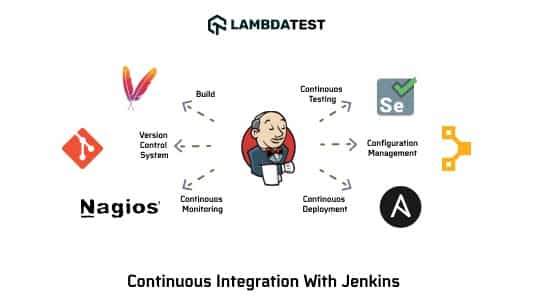
Key Features
- Supports all important languages.
- An open-source or free code base, which is written in Java.
- Ease of maintenance as it has an in-built GUI tool to upgrade.
- Runs on third-party cloud hosting choice or your own private server.
- Fully compatible with any version control system.
- Great Jenkins pipeline syntax creating a script that assists in automating several procedures, including testing.
- Configuration through Jenkinsfile; can be custom to minute detail. However, it is probably one of the more complicated processes, yet the support of pipeline scripts makes it a little simpler.
- Extensively its elements are open and free to use. However, one can’t underestimate the DevOps engineer’s cost and time to custom, build, and run the environment.
If you are seeking for an open-source (and inexpensive) CI (Continuous Integration) solution and need assistance from a reputed community, this fantastic CI/CD tool is the right choice for you.
Read – Learn how to do continuous integration with one of the most popular CI/CD tool, Jenkins.
2. Travis CI
Travis CI is another outstanding and popular tool in the CI/CD arena. It was mainly launched for open-source projects and then expanded to closed-source projects over some decades. This tool focuses mostly on CI (Continuous Integration), enhancing the build procedure’s performance with test automation and an alert system. You can rapidly test your existing code – this incredible tool will supervise all modifications and allow you to know if the alteration is doing well or not. Some other tools like CircleCI, Travis CI are perfect to make your initial steps in CI (Continuous Integration) out-of-the-box solutions.
It mainly functions for the GitHub SCM tool. Travis CI is mostly written in Ruby. It functions as a CI tool only. Travis CI tool is developed by the Travis CI community and chiefly supports web platforms. It has excellent traits such as: faster setup, pre-installed database services, live-build views, and auto-deployment on passing builds, pull request support, deploy anywhere, clean virtual machines for each build, support approximately every single platform such as Linux, Mac, etc.
Unlike other CI/CD tools, this tool does support the build matrix – providing a chance to execute tests with varied packages and versions of languages. You can easily customize it the way you wish to. For instance, failures in a few environments can activate notifications; however, it will not fail the whole build (which is useful for development versions of packages).
Setting It Up
Below are the steps-
- To begin using Travis CI, browse Travis-ci.com & Sign up with GitHub.
- Allow the Authorization of Travis CI.
- After that click on your account picture in the top right corner of your Travis Dashboard, click Settings & then the green Activate button, and choose the repositories you would like to use with the tool.
What Does It Mainly Do?
- Travis CI concentrates on enabling users to rapidly test their code as it is deployed. It supports small and large code alterations and is well-designed to detect alterations in building as well as testing. When a modification is identified, this incredible CI/ CD tool can immediately provide a reaction whether the alteration was successful or not.
- It supports testing the open-source app for free and charges you to test private apps. Two main build flows that pull request build flow and branch build flow. This tool support about 30 varied programming languages like GO, Xcode, Java, Ruby, Python, Haskell, Clojure, PHP, Node, Perl, Scala, C#, and much more.
- Travis CI can be configured after integrating the filename.travis.yml. This is a file with YAML format found in the GitHub repository. Travis CI supports the incorporation of external tools also.
- Software developers can easily use Travis CI to notice the tests as they execute, run various tests in parallel, and incorporate the tool with HipChat, Email, Slack, etc. to get alerted of problems or failed builds.
- It also supports container build and additionally supports OSX and Linux Ubuntu. It has a restricted list of third-party integrations; however, as the concentration is on Continuous Integration (CI) rather than CD (Continuous Delivery), it might not be a problem for your use case.
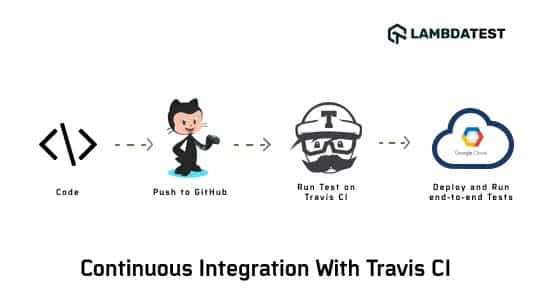
Key Features
- Free to test open-source apps.
- Supports amalgamation with external tools.
- Several parts of the software are open on GitHub, with a few private codes written in a language like Ruby.
- Offer both a private server & cloud hosted choices.
- Support numerous languages like Python, Scala, Ruby, Perl, that are built using macOS, Linux, and significantly— Windows.
- No free plan (restricted a free trial for 100 first builds and two concurrent jobs)
- Version Control Software (VCS) is GitHub.
- Testing that can be completed on apps or library against numerous runtimes and data stores without the requirement of installation locally over several OSs (operating systems).
- Lightweight and well-documented yml configuration settings; easy set-up of projects thanks to in-built services and databases.
- The out-of-the-box cloud solution that is comparatively simple to manage and maintain once set-up.
In case if your code is free or open-source and you are more worried about the CI (Continuous Integration) of your builds, this amazing CI/ CD tool is worth it for you.
3. Bamboo
Developed by Atlassian in 2007, Bamboo is the significant automation server used for CI that automatically builds, tests, deploys the source code, and sets up the app for deployment. This licensed tool offers high-end visibility over the entire development, testing, & deployment process. Bamboo comes with great flexibility to use several tools and simple to use GUI. It also supports numerous languages and enables software developers to use CI/CD methodologies. It has robust integrations to different Atlassian products that are relevant for the Continuous Integration cycle, like Bitbucket and Jira.
With this amazing tool, you can ensure superior quality and status, get in-depth visibility into release execution, and spend the utmost time writing the code rather than integrating other software. Bamboo also gives built-in deployment hold, automated merging, robust build agent management, and built-in Git branch workflows.
Setting It Up
Install Java, just after installing it and forming a dedicated user to run Bamboo, follow these steps:
- Download Bamboo.
- Generate an installation directory.
- Create the home directory.
- Start Bamboo and start configuring Bamboo.
What Does It Mainly Do?
- The building, integrating, testing, and setting up are all divisions of its package, as well as the software test part is made with the support of a Bamboo agent. Just like the Java monitoring agents, this amazing tool also provides two options. The remote agents execute on other servers and computers whilst the local agents execute as a section of the Bamboo server (part of its procedure). Every single agent is allocated for builds that match its capacities, which lets assigning dissimilar agents to dissimilar builds.
- The key benefit that Bamboo provides is the strong tie-up to Atlassian’s rest products, like Bitbucket and Jira. Using Bamboo, you can observe code alterations and Jira problems that have been brought into the code as the final deployment. In this way, software developers can synchronize their flow of work and always continue on track & recognize which version is after that and what (must) have been set.
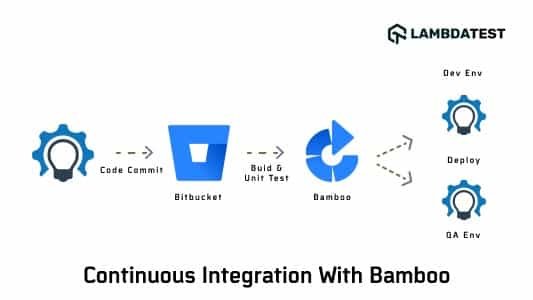
Key Features
- Bitbucket and Jira software server integration for high-end visibility into release execution, status, and quality.
- Send a continuous build flow to the testing environment and automated release builds to users.
- Automated integration between Mercurial and Git branches.
- Extraordinary build agent management which enables you to scale build capability by linking servers on your network through Amazon EC2. You can easily visualize system necessities for every single build with the Agent Matrix attribute, permitting you to allocate builds to the correct agents.
- Straight from the branch name, you can automatically identify, build, test, and combine branches for deploying code constantly to staging or production servers.
- Support is accessible for company teams.
- Comes with Atlassian’s strong support, together with great workflows for the organization’s current products. If anyone is willing to incorporate Bitbucket and JIRA to your Continuous Integration procedure in a flawless mode and wish to pay for it, Bamboo is a great attempt.
Overall, Bamboo is a powerful tool as long as you are making use of it with Jira and Bitbucket and willing to pay for your Continuous Integration (CI) solution.
4. TeamCity
TeamCity is the most-admired and popular commercial CI/CD server, which is also a Java-based CI server package. It is an automation server and a building management tool. JetBrains made TeamCity. TeamCity enables users to better fit the tool to their own necessities and environment. Its server is a prime component, yet the interface (browser-hosted) serves as the main mode to administer this tool’s users, agents, plans, & build configuration. It manages project status and reporting information appropriate for a broad range of project stakeholders and users. TeamCity offers drill-down detail, build development, and historical detail on the configurations and projects.
TeamCity offers CI “out of the box” and offers assistance for numerous languages (Ruby, .NET, Java, and several others). It contains JetBrains to back the tool up with support and records wisely. Its slick GUI and simple to use attributes make it more pleasant for some new to CI. This fantastic tool runs in a Java environment, mainly on an Apache Tomcat server, while it can be installed on both Linux and Windows servers. It provides huge assistance and support for OpenStack & .NET projects, integrating into both IDEs like Eclipse and Visual Studio.
Setting It Up
These are the steps to follow-
- You have to Download TeamCity from the authentic site.
- Choose the installation directory that follows the configuration.
What Does It Mainly Do?
- As one of the best software test tools, it aims to enhance release cycles. With TeamCity, you can review on-the-fly of testing outcomes, notice code coverage and locate duplicates, plus customize statistics on build interval, code quality, success rate, as well as other custom metrics.
- It provides restricted characteristics as freeware under a few terms and conditions. TeamCity supports servlet based servers such as Apache Tomcat etc. TeamCity also supports varied important platforms like.NET, Java, and Ruby.
- Once this amazing tool detects a modification in a version control system, it automatically adds a build to the get-in-line. The server discovers an idle attuned build agent and allocates the queued build to this agent, which runs the build actions.
- While this procedure runs, TeamCity server logs the varied log messages, testing reports, as well as other alterations that are being completed. The modifications are saved, synced and uploaded in real-time, so users can understand what is going to happen with the build as they make modifications to it. The TeamCity tool also provides an opportunity to run parallel builds concurrently on distinct environments and platforms.
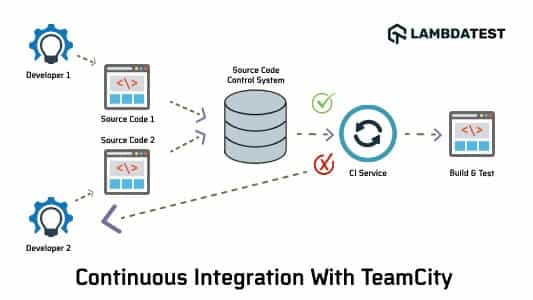
Key Features
- Private code-base CI/ CD tool written in Java.
- Provides both a hosted and private server cloud options.
- VCS: Back-up projects using both GitHub & Bitbucket.
- Deep emphasis on quality of test as well as test metadata.
- An out-of-the-box cloud solution that is comparatively trouble-free to maintain once deployed.
- Lightweight yml configuration settings are perfectly documented.
- Provides various means to reprocess the settings of a parent project in a subproject.
- Takes the source code from 2 varied VCS (version control systems), for a solitary build.
- Unrestricted build configurations for 60 days to try CI.
- Provides a rather useful free-version that offers you unlimited build and 100 build configurations. After that, costs start at USD 299.
- Comes with a preference of gated commits, which can support software developers from breaking sources in a VCS (version control systems). This is made by successfully running the build remotely for local alterations before you commit it.
This is one of the incredible CI/ CD tools that has been gaining fame over the past few decades, providing a decent option as compared to other CI tools available in the marketplace. Besides, if you are interested to check your builds and tests as they come about, or want a powerful and free Continuous Integration (CI) solution, there is no doubt that TeamCity is worth checking out.
Jenkins vs Travis vs Bamboo vs TeamCity: Key Differences
| Feature | Jenkins | Travis | Bamboo | TeamCity |
|---|---|---|---|---|
|
Pricing |
Free |
Starts at $69 per month |
Plan starts at $10 with restricted experience, however,
licensed versions charge around $880 for one remote |
$ 299 Annual charge. Free for 100 build configuration. |
|
Software model |
Open-source |
Some private (some open source) |
Commercial tool |
Free for open-source projects |
|
Ease of set-up |
Easy
|
No installation required |
Medium
|
Easy
|
|
Origin |
Java |
Java |
Java |
Java |
|
User-friendliness |
Less user-friendly as this tool is entirely based on |
Travis CI has a user-friendly Graphical User Interface |
More user-friendly as it has an intuitive UI.
Gives proper guidance throughout the planning,
|
Extra user-friendly with out-of-the-box usability. It |
|
Documentation |
Excellent online documentation |
Good online documentation |
Good online documentation |
Excellent online documentation |
|
Platform dependency |
Supports varied platforms, OS/browsers– RedHat, |
Doesn’t support Window just support Mac and Linux, |
Supports distinct OSs and browsers – Windows, Solaris, |
Supports varied platforms – Tomcat server, Apache |
|
Hosting |
On-premise/cloud-based |
Self-hosted/On-Premise |
On-premise |
On-premise |
|
Plugins Support |
Discover |
Discover |
Discover |
Discover |
|
Ease of Use
|
Customizable through the accessible plugins |
Concentrate on functionality and usability. Quite |
Friendly & intuitive UI, which can be custom as per |
The interface of TeamCity, easy setup, and incredible |
|
Cloud solution |
YES |
YES |
YES |
YES |
|
Support |
Provides Global support |
Gives great support to Licensed users |
Provides support to Licensed users |
Offers Global support |
Commercial vs Open Source
Travis CI and Jenkins are open-source projects supported by software developers across the globe. TeamCity and Bamboo are both popular commercial CI/CD tools developed and managed by their parent businesses. The major difference for the user is the community size found roughly about Jenkins versus the other CI/ CD tools.
What To Consider When Picking Out The Right CI/ CD Tool?
- Where is the tool hosted? Hosting is important. Cloud-based tools need the least configuration and can be attuned as per the user’s requirements. When thinking about self-hosted solutions, the task to manage it rests with the in-house team of DevOps testing. The former choices reduce setup complications, while the latter provides immense flexibility.
- Usability: A well-designed and clever interface makes the entire building procedure much simpler. One looks for a clear-cut and easy Graphical User Interface and UX.
- Great integrations: A perfect Continuous Integration tool should be incorporated with other tools commonly used in the software development procedure. It might project legal compliance tools, static analysis tools, management tools (Jira), incident filing tools (Bugzilla), and so on. It should also support build tools (Maven, Gradle) as well as VCS (Perforce, Git,).
- Reusable code library: Remember to select a tool comprising a public library of various plugins as well as usable build steps. This could be commercially accessible or open-source.
- Container support: CI/ CD tools that are configured for container orchestration tools (Kubernetes, Docker) or have a deploy plugin have a great time connecting to an app’s niche environment.
Wrapping Up
While selecting the right CI/CD tool, you will need to glance at your internal resources, budget, and amount of time you wish to spend on the setup and learning. However, before you decide on your tool, there are some significant aspects that you should consider:
- Management and support provided by tools
- User interface (UI) & integration support
- Type of systems like large software systems and standalone systems
These are just a few relevant parameters you have to bear in mind before selecting one between Jenkins vs Travis vs Bamboo vs TeamCity. To sum up, we can say that all of these CI/CD tools serve a purpose in their own way. Remember that your CI/CD tools are merely one of the tools you will require to win the software development race. Application monitoring and deployment are just as significant elements of agile development. Furthermore, employing cloud-based browser compatibility testing tools like LambdaTest can help escalate the entire process for your teams. Consider all the aspects & then choose between Jenkins vs Travis vs Bamboo vs TeamCity.
Happy testing!
Got Questions? Drop them on LambdaTest Community. Visit now










